Cognitive Development - Questions and Solutions
VerifiedAdded on 2022/08/15
|17
|4071
|18
AI Summary
Contribute Materials
Your contribution can guide someone’s learning journey. Share your
documents today.
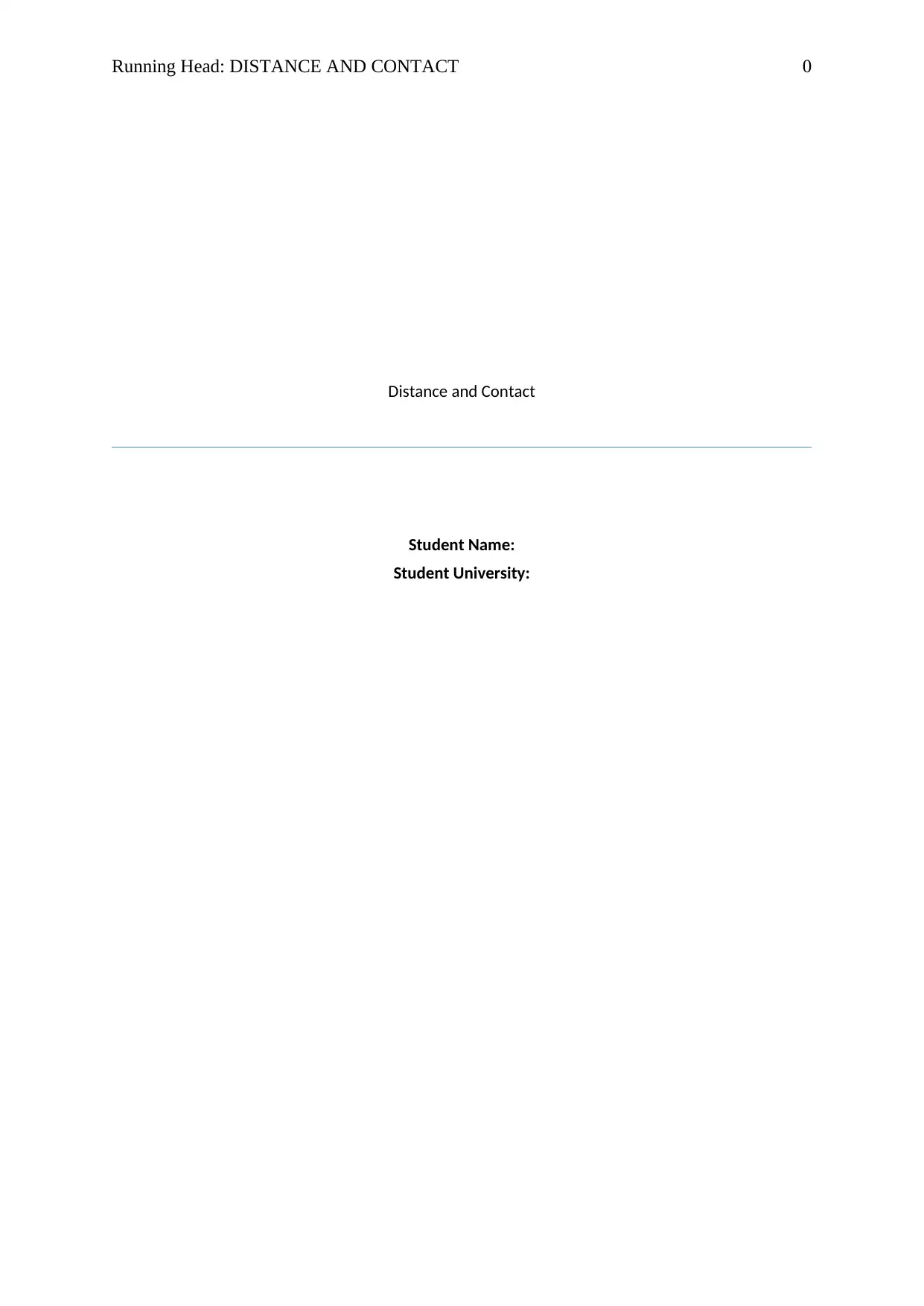
Running Head: DISTANCE AND CONTACT 0
Distance and Contact
Student Name:
Student University:
Distance and Contact
Student Name:
Student University:
Secure Best Marks with AI Grader
Need help grading? Try our AI Grader for instant feedback on your assignments.
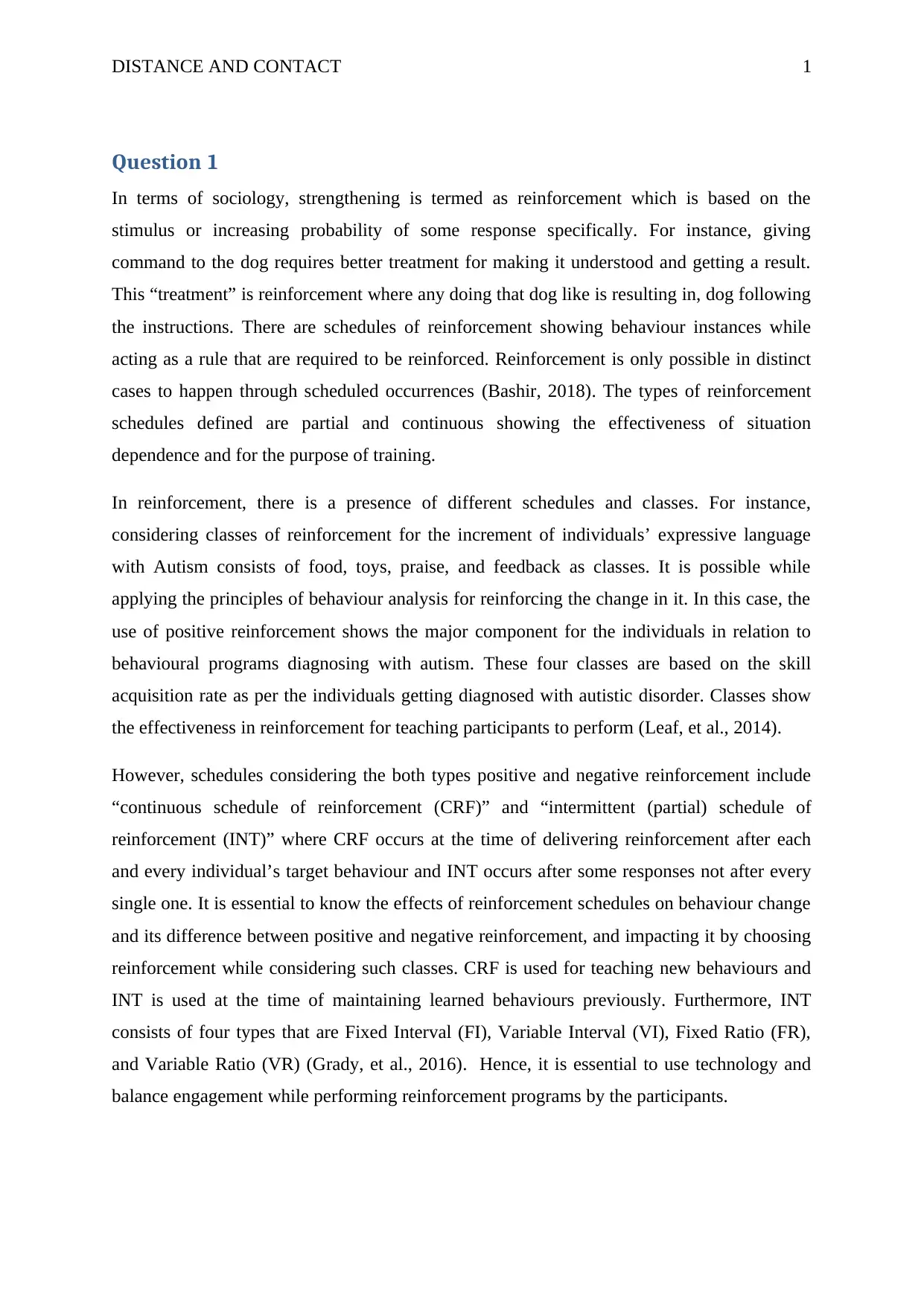
DISTANCE AND CONTACT 1
Question 1
In terms of sociology, strengthening is termed as reinforcement which is based on the
stimulus or increasing probability of some response specifically. For instance, giving
command to the dog requires better treatment for making it understood and getting a result.
This “treatment” is reinforcement where any doing that dog like is resulting in, dog following
the instructions. There are schedules of reinforcement showing behaviour instances while
acting as a rule that are required to be reinforced. Reinforcement is only possible in distinct
cases to happen through scheduled occurrences (Bashir, 2018). The types of reinforcement
schedules defined are partial and continuous showing the effectiveness of situation
dependence and for the purpose of training.
In reinforcement, there is a presence of different schedules and classes. For instance,
considering classes of reinforcement for the increment of individuals’ expressive language
with Autism consists of food, toys, praise, and feedback as classes. It is possible while
applying the principles of behaviour analysis for reinforcing the change in it. In this case, the
use of positive reinforcement shows the major component for the individuals in relation to
behavioural programs diagnosing with autism. These four classes are based on the skill
acquisition rate as per the individuals getting diagnosed with autistic disorder. Classes show
the effectiveness in reinforcement for teaching participants to perform (Leaf, et al., 2014).
However, schedules considering the both types positive and negative reinforcement include
“continuous schedule of reinforcement (CRF)” and “intermittent (partial) schedule of
reinforcement (INT)” where CRF occurs at the time of delivering reinforcement after each
and every individual’s target behaviour and INT occurs after some responses not after every
single one. It is essential to know the effects of reinforcement schedules on behaviour change
and its difference between positive and negative reinforcement, and impacting it by choosing
reinforcement while considering such classes. CRF is used for teaching new behaviours and
INT is used at the time of maintaining learned behaviours previously. Furthermore, INT
consists of four types that are Fixed Interval (FI), Variable Interval (VI), Fixed Ratio (FR),
and Variable Ratio (VR) (Grady, et al., 2016). Hence, it is essential to use technology and
balance engagement while performing reinforcement programs by the participants.
Question 1
In terms of sociology, strengthening is termed as reinforcement which is based on the
stimulus or increasing probability of some response specifically. For instance, giving
command to the dog requires better treatment for making it understood and getting a result.
This “treatment” is reinforcement where any doing that dog like is resulting in, dog following
the instructions. There are schedules of reinforcement showing behaviour instances while
acting as a rule that are required to be reinforced. Reinforcement is only possible in distinct
cases to happen through scheduled occurrences (Bashir, 2018). The types of reinforcement
schedules defined are partial and continuous showing the effectiveness of situation
dependence and for the purpose of training.
In reinforcement, there is a presence of different schedules and classes. For instance,
considering classes of reinforcement for the increment of individuals’ expressive language
with Autism consists of food, toys, praise, and feedback as classes. It is possible while
applying the principles of behaviour analysis for reinforcing the change in it. In this case, the
use of positive reinforcement shows the major component for the individuals in relation to
behavioural programs diagnosing with autism. These four classes are based on the skill
acquisition rate as per the individuals getting diagnosed with autistic disorder. Classes show
the effectiveness in reinforcement for teaching participants to perform (Leaf, et al., 2014).
However, schedules considering the both types positive and negative reinforcement include
“continuous schedule of reinforcement (CRF)” and “intermittent (partial) schedule of
reinforcement (INT)” where CRF occurs at the time of delivering reinforcement after each
and every individual’s target behaviour and INT occurs after some responses not after every
single one. It is essential to know the effects of reinforcement schedules on behaviour change
and its difference between positive and negative reinforcement, and impacting it by choosing
reinforcement while considering such classes. CRF is used for teaching new behaviours and
INT is used at the time of maintaining learned behaviours previously. Furthermore, INT
consists of four types that are Fixed Interval (FI), Variable Interval (VI), Fixed Ratio (FR),
and Variable Ratio (VR) (Grady, et al., 2016). Hence, it is essential to use technology and
balance engagement while performing reinforcement programs by the participants.
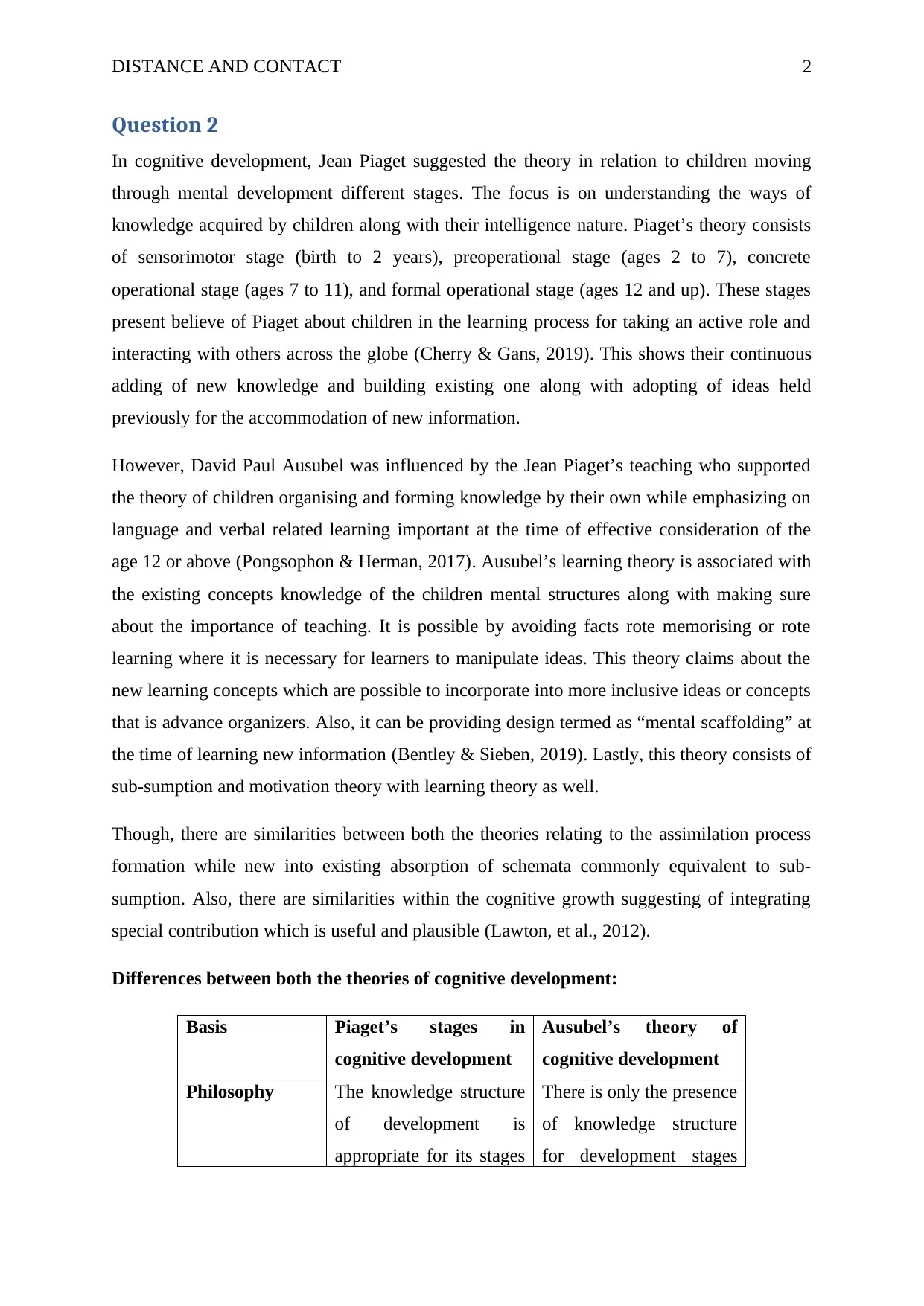
DISTANCE AND CONTACT 2
Question 2
In cognitive development, Jean Piaget suggested the theory in relation to children moving
through mental development different stages. The focus is on understanding the ways of
knowledge acquired by children along with their intelligence nature. Piaget’s theory consists
of sensorimotor stage (birth to 2 years), preoperational stage (ages 2 to 7), concrete
operational stage (ages 7 to 11), and formal operational stage (ages 12 and up). These stages
present believe of Piaget about children in the learning process for taking an active role and
interacting with others across the globe (Cherry & Gans, 2019). This shows their continuous
adding of new knowledge and building existing one along with adopting of ideas held
previously for the accommodation of new information.
However, David Paul Ausubel was influenced by the Jean Piaget’s teaching who supported
the theory of children organising and forming knowledge by their own while emphasizing on
language and verbal related learning important at the time of effective consideration of the
age 12 or above (Pongsophon & Herman, 2017). Ausubel’s learning theory is associated with
the existing concepts knowledge of the children mental structures along with making sure
about the importance of teaching. It is possible by avoiding facts rote memorising or rote
learning where it is necessary for learners to manipulate ideas. This theory claims about the
new learning concepts which are possible to incorporate into more inclusive ideas or concepts
that is advance organizers. Also, it can be providing design termed as “mental scaffolding” at
the time of learning new information (Bentley & Sieben, 2019). Lastly, this theory consists of
sub-sumption and motivation theory with learning theory as well.
Though, there are similarities between both the theories relating to the assimilation process
formation while new into existing absorption of schemata commonly equivalent to sub-
sumption. Also, there are similarities within the cognitive growth suggesting of integrating
special contribution which is useful and plausible (Lawton, et al., 2012).
Differences between both the theories of cognitive development:
Basis Piaget’s stages in
cognitive development
Ausubel’s theory of
cognitive development
Philosophy The knowledge structure
of development is
appropriate for its stages
There is only the presence
of knowledge structure
for development stages
Question 2
In cognitive development, Jean Piaget suggested the theory in relation to children moving
through mental development different stages. The focus is on understanding the ways of
knowledge acquired by children along with their intelligence nature. Piaget’s theory consists
of sensorimotor stage (birth to 2 years), preoperational stage (ages 2 to 7), concrete
operational stage (ages 7 to 11), and formal operational stage (ages 12 and up). These stages
present believe of Piaget about children in the learning process for taking an active role and
interacting with others across the globe (Cherry & Gans, 2019). This shows their continuous
adding of new knowledge and building existing one along with adopting of ideas held
previously for the accommodation of new information.
However, David Paul Ausubel was influenced by the Jean Piaget’s teaching who supported
the theory of children organising and forming knowledge by their own while emphasizing on
language and verbal related learning important at the time of effective consideration of the
age 12 or above (Pongsophon & Herman, 2017). Ausubel’s learning theory is associated with
the existing concepts knowledge of the children mental structures along with making sure
about the importance of teaching. It is possible by avoiding facts rote memorising or rote
learning where it is necessary for learners to manipulate ideas. This theory claims about the
new learning concepts which are possible to incorporate into more inclusive ideas or concepts
that is advance organizers. Also, it can be providing design termed as “mental scaffolding” at
the time of learning new information (Bentley & Sieben, 2019). Lastly, this theory consists of
sub-sumption and motivation theory with learning theory as well.
Though, there are similarities between both the theories relating to the assimilation process
formation while new into existing absorption of schemata commonly equivalent to sub-
sumption. Also, there are similarities within the cognitive growth suggesting of integrating
special contribution which is useful and plausible (Lawton, et al., 2012).
Differences between both the theories of cognitive development:
Basis Piaget’s stages in
cognitive development
Ausubel’s theory of
cognitive development
Philosophy The knowledge structure
of development is
appropriate for its stages
There is only the presence
of knowledge structure
for development stages
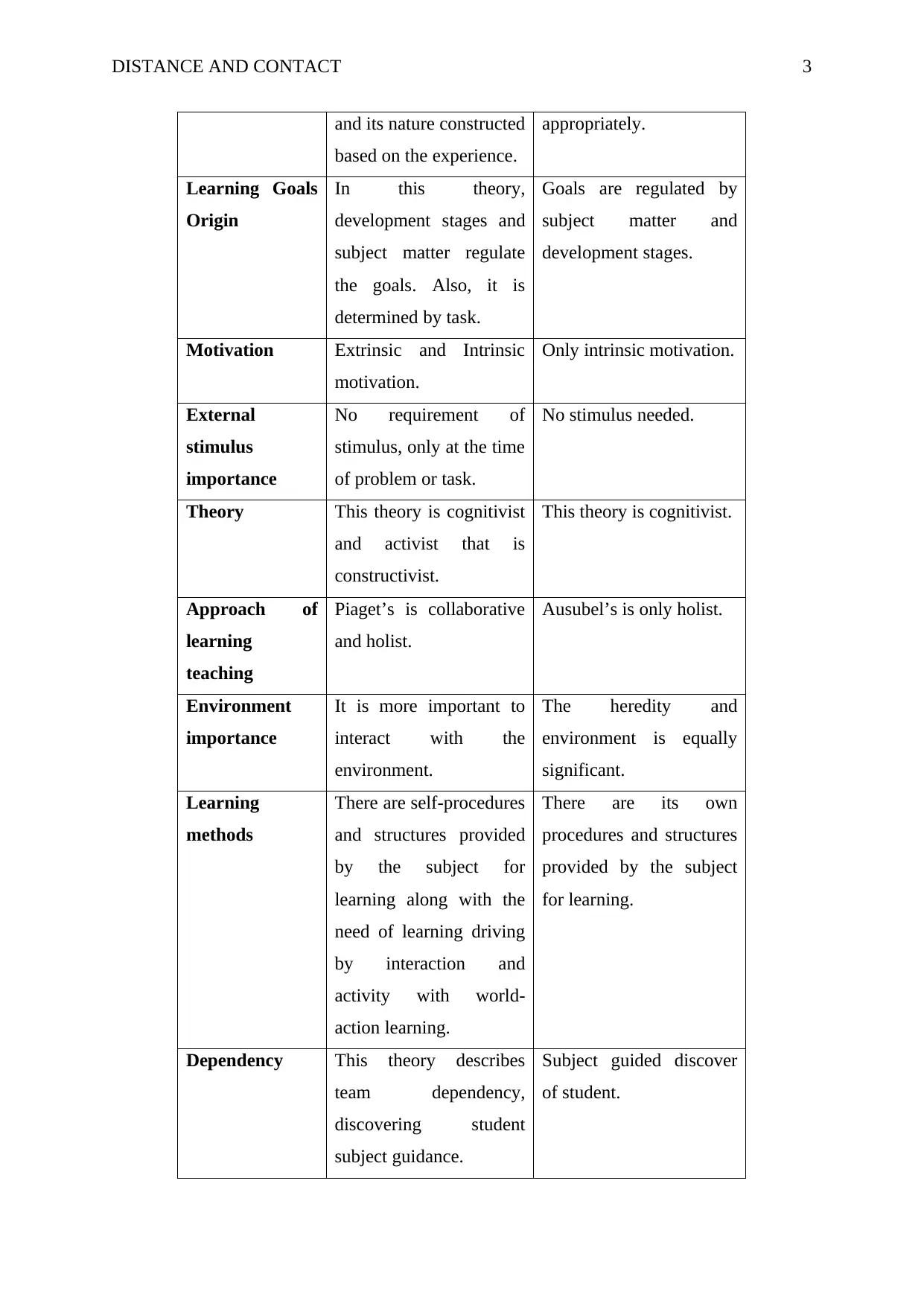
DISTANCE AND CONTACT 3
and its nature constructed
based on the experience.
appropriately.
Learning Goals
Origin
In this theory,
development stages and
subject matter regulate
the goals. Also, it is
determined by task.
Goals are regulated by
subject matter and
development stages.
Motivation Extrinsic and Intrinsic
motivation.
Only intrinsic motivation.
External
stimulus
importance
No requirement of
stimulus, only at the time
of problem or task.
No stimulus needed.
Theory This theory is cognitivist
and activist that is
constructivist.
This theory is cognitivist.
Approach of
learning
teaching
Piaget’s is collaborative
and holist.
Ausubel’s is only holist.
Environment
importance
It is more important to
interact with the
environment.
The heredity and
environment is equally
significant.
Learning
methods
There are self-procedures
and structures provided
by the subject for
learning along with the
need of learning driving
by interaction and
activity with world-
action learning.
There are its own
procedures and structures
provided by the subject
for learning.
Dependency This theory describes
team dependency,
discovering student
subject guidance.
Subject guided discover
of student.
and its nature constructed
based on the experience.
appropriately.
Learning Goals
Origin
In this theory,
development stages and
subject matter regulate
the goals. Also, it is
determined by task.
Goals are regulated by
subject matter and
development stages.
Motivation Extrinsic and Intrinsic
motivation.
Only intrinsic motivation.
External
stimulus
importance
No requirement of
stimulus, only at the time
of problem or task.
No stimulus needed.
Theory This theory is cognitivist
and activist that is
constructivist.
This theory is cognitivist.
Approach of
learning
teaching
Piaget’s is collaborative
and holist.
Ausubel’s is only holist.
Environment
importance
It is more important to
interact with the
environment.
The heredity and
environment is equally
significant.
Learning
methods
There are self-procedures
and structures provided
by the subject for
learning along with the
need of learning driving
by interaction and
activity with world-
action learning.
There are its own
procedures and structures
provided by the subject
for learning.
Dependency This theory describes
team dependency,
discovering student
subject guidance.
Subject guided discover
of student.
Secure Best Marks with AI Grader
Need help grading? Try our AI Grader for instant feedback on your assignments.
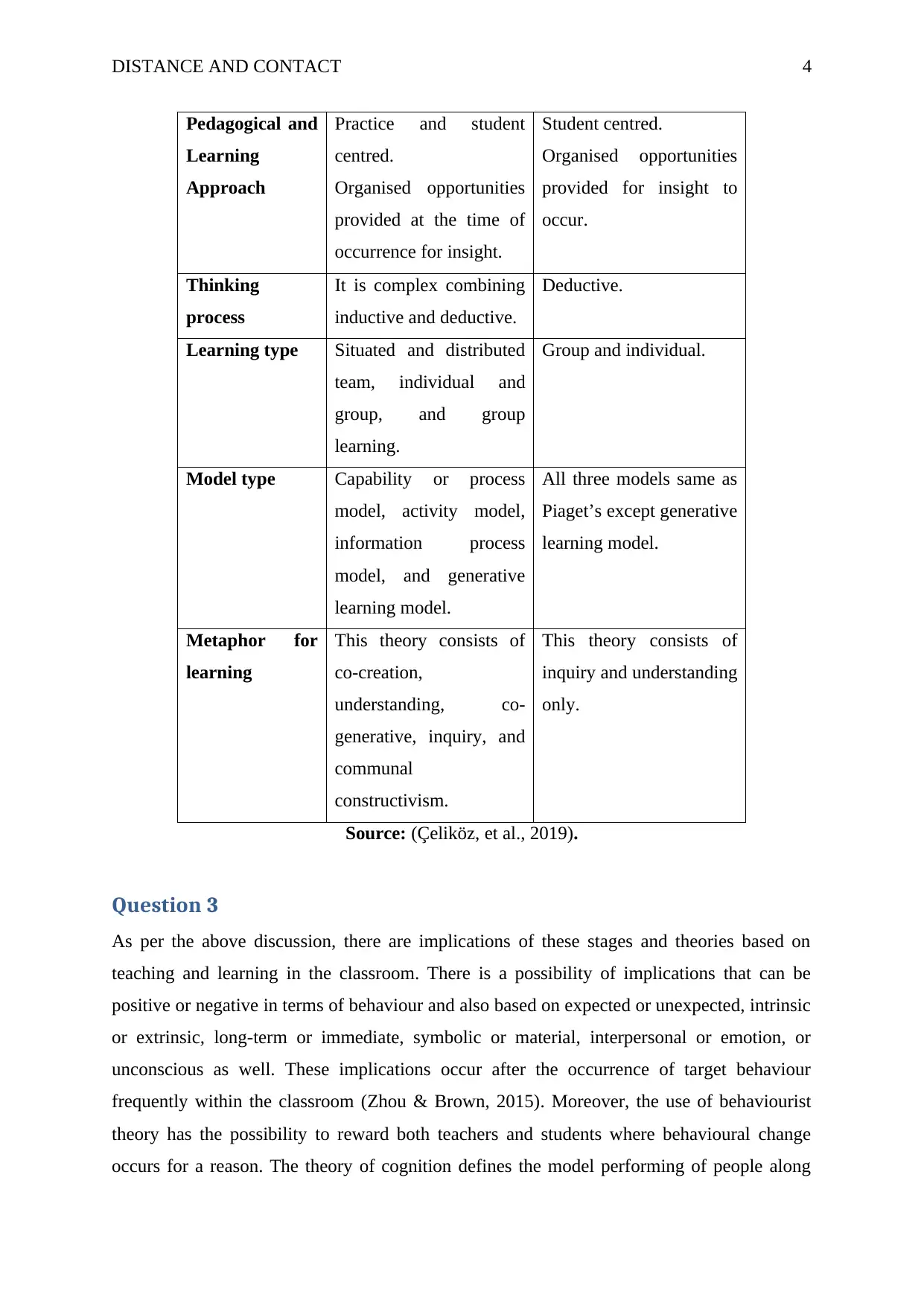
DISTANCE AND CONTACT 4
Pedagogical and
Learning
Approach
Practice and student
centred.
Organised opportunities
provided at the time of
occurrence for insight.
Student centred.
Organised opportunities
provided for insight to
occur.
Thinking
process
It is complex combining
inductive and deductive.
Deductive.
Learning type Situated and distributed
team, individual and
group, and group
learning.
Group and individual.
Model type Capability or process
model, activity model,
information process
model, and generative
learning model.
All three models same as
Piaget’s except generative
learning model.
Metaphor for
learning
This theory consists of
co-creation,
understanding, co-
generative, inquiry, and
communal
constructivism.
This theory consists of
inquiry and understanding
only.
Source: (Çeliköz, et al., 2019).
Question 3
As per the above discussion, there are implications of these stages and theories based on
teaching and learning in the classroom. There is a possibility of implications that can be
positive or negative in terms of behaviour and also based on expected or unexpected, intrinsic
or extrinsic, long-term or immediate, symbolic or material, interpersonal or emotion, or
unconscious as well. These implications occur after the occurrence of target behaviour
frequently within the classroom (Zhou & Brown, 2015). Moreover, the use of behaviourist
theory has the possibility to reward both teachers and students where behavioural change
occurs for a reason. The theory of cognition defines the model performing of people along
Pedagogical and
Learning
Approach
Practice and student
centred.
Organised opportunities
provided at the time of
occurrence for insight.
Student centred.
Organised opportunities
provided for insight to
occur.
Thinking
process
It is complex combining
inductive and deductive.
Deductive.
Learning type Situated and distributed
team, individual and
group, and group
learning.
Group and individual.
Model type Capability or process
model, activity model,
information process
model, and generative
learning model.
All three models same as
Piaget’s except generative
learning model.
Metaphor for
learning
This theory consists of
co-creation,
understanding, co-
generative, inquiry, and
communal
constructivism.
This theory consists of
inquiry and understanding
only.
Source: (Çeliköz, et al., 2019).
Question 3
As per the above discussion, there are implications of these stages and theories based on
teaching and learning in the classroom. There is a possibility of implications that can be
positive or negative in terms of behaviour and also based on expected or unexpected, intrinsic
or extrinsic, long-term or immediate, symbolic or material, interpersonal or emotion, or
unconscious as well. These implications occur after the occurrence of target behaviour
frequently within the classroom (Zhou & Brown, 2015). Moreover, the use of behaviourist
theory has the possibility to reward both teachers and students where behavioural change
occurs for a reason. The theory of cognition defines the model performing of people along
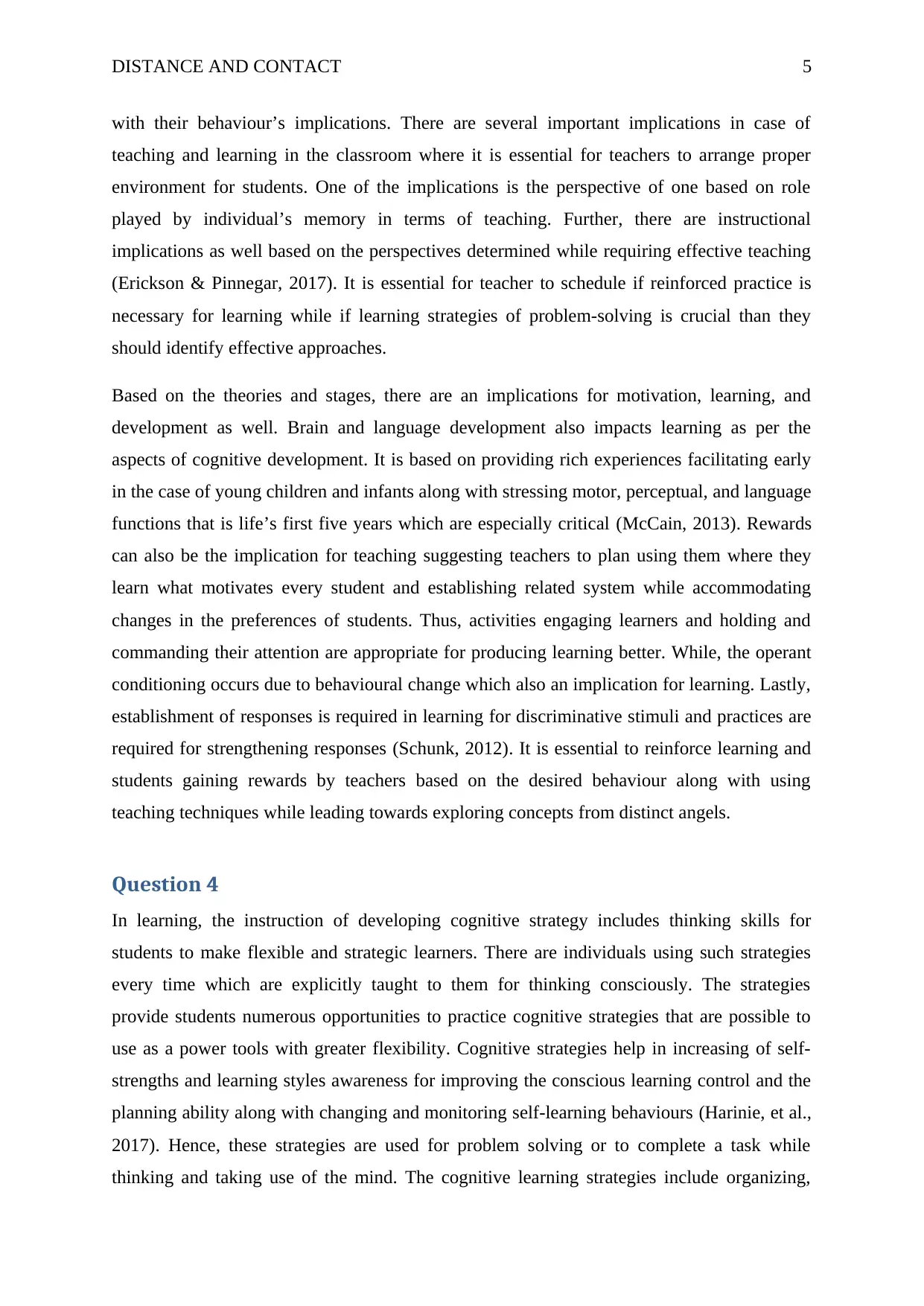
DISTANCE AND CONTACT 5
with their behaviour’s implications. There are several important implications in case of
teaching and learning in the classroom where it is essential for teachers to arrange proper
environment for students. One of the implications is the perspective of one based on role
played by individual’s memory in terms of teaching. Further, there are instructional
implications as well based on the perspectives determined while requiring effective teaching
(Erickson & Pinnegar, 2017). It is essential for teacher to schedule if reinforced practice is
necessary for learning while if learning strategies of problem-solving is crucial than they
should identify effective approaches.
Based on the theories and stages, there are an implications for motivation, learning, and
development as well. Brain and language development also impacts learning as per the
aspects of cognitive development. It is based on providing rich experiences facilitating early
in the case of young children and infants along with stressing motor, perceptual, and language
functions that is life’s first five years which are especially critical (McCain, 2013). Rewards
can also be the implication for teaching suggesting teachers to plan using them where they
learn what motivates every student and establishing related system while accommodating
changes in the preferences of students. Thus, activities engaging learners and holding and
commanding their attention are appropriate for producing learning better. While, the operant
conditioning occurs due to behavioural change which also an implication for learning. Lastly,
establishment of responses is required in learning for discriminative stimuli and practices are
required for strengthening responses (Schunk, 2012). It is essential to reinforce learning and
students gaining rewards by teachers based on the desired behaviour along with using
teaching techniques while leading towards exploring concepts from distinct angels.
Question 4
In learning, the instruction of developing cognitive strategy includes thinking skills for
students to make flexible and strategic learners. There are individuals using such strategies
every time which are explicitly taught to them for thinking consciously. The strategies
provide students numerous opportunities to practice cognitive strategies that are possible to
use as a power tools with greater flexibility. Cognitive strategies help in increasing of self-
strengths and learning styles awareness for improving the conscious learning control and the
planning ability along with changing and monitoring self-learning behaviours (Harinie, et al.,
2017). Hence, these strategies are used for problem solving or to complete a task while
thinking and taking use of the mind. The cognitive learning strategies include organizing,
with their behaviour’s implications. There are several important implications in case of
teaching and learning in the classroom where it is essential for teachers to arrange proper
environment for students. One of the implications is the perspective of one based on role
played by individual’s memory in terms of teaching. Further, there are instructional
implications as well based on the perspectives determined while requiring effective teaching
(Erickson & Pinnegar, 2017). It is essential for teacher to schedule if reinforced practice is
necessary for learning while if learning strategies of problem-solving is crucial than they
should identify effective approaches.
Based on the theories and stages, there are an implications for motivation, learning, and
development as well. Brain and language development also impacts learning as per the
aspects of cognitive development. It is based on providing rich experiences facilitating early
in the case of young children and infants along with stressing motor, perceptual, and language
functions that is life’s first five years which are especially critical (McCain, 2013). Rewards
can also be the implication for teaching suggesting teachers to plan using them where they
learn what motivates every student and establishing related system while accommodating
changes in the preferences of students. Thus, activities engaging learners and holding and
commanding their attention are appropriate for producing learning better. While, the operant
conditioning occurs due to behavioural change which also an implication for learning. Lastly,
establishment of responses is required in learning for discriminative stimuli and practices are
required for strengthening responses (Schunk, 2012). It is essential to reinforce learning and
students gaining rewards by teachers based on the desired behaviour along with using
teaching techniques while leading towards exploring concepts from distinct angels.
Question 4
In learning, the instruction of developing cognitive strategy includes thinking skills for
students to make flexible and strategic learners. There are individuals using such strategies
every time which are explicitly taught to them for thinking consciously. The strategies
provide students numerous opportunities to practice cognitive strategies that are possible to
use as a power tools with greater flexibility. Cognitive strategies help in increasing of self-
strengths and learning styles awareness for improving the conscious learning control and the
planning ability along with changing and monitoring self-learning behaviours (Harinie, et al.,
2017). Hence, these strategies are used for problem solving or to complete a task while
thinking and taking use of the mind. The cognitive learning strategies include organizing,
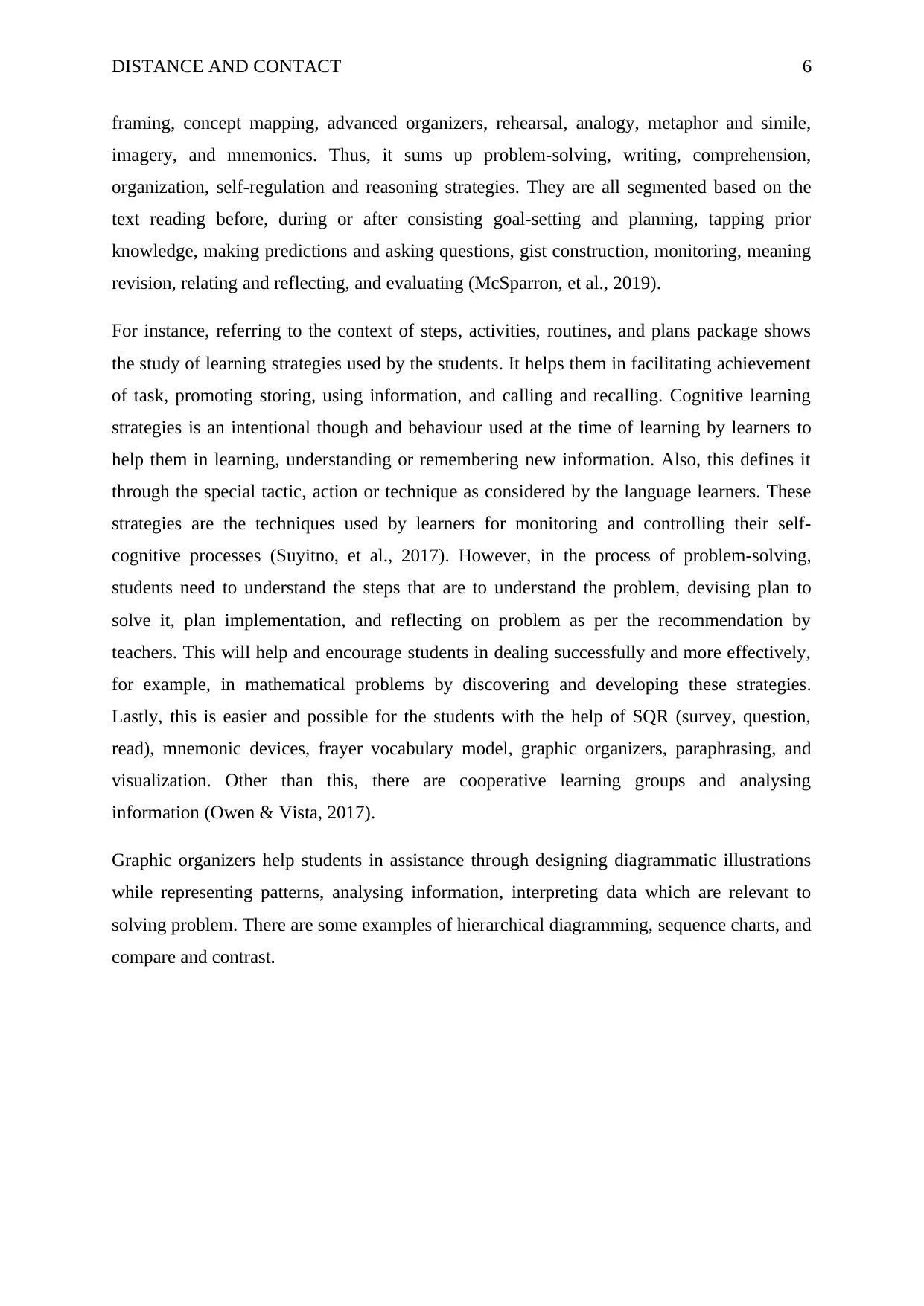
DISTANCE AND CONTACT 6
framing, concept mapping, advanced organizers, rehearsal, analogy, metaphor and simile,
imagery, and mnemonics. Thus, it sums up problem-solving, writing, comprehension,
organization, self-regulation and reasoning strategies. They are all segmented based on the
text reading before, during or after consisting goal-setting and planning, tapping prior
knowledge, making predictions and asking questions, gist construction, monitoring, meaning
revision, relating and reflecting, and evaluating (McSparron, et al., 2019).
For instance, referring to the context of steps, activities, routines, and plans package shows
the study of learning strategies used by the students. It helps them in facilitating achievement
of task, promoting storing, using information, and calling and recalling. Cognitive learning
strategies is an intentional though and behaviour used at the time of learning by learners to
help them in learning, understanding or remembering new information. Also, this defines it
through the special tactic, action or technique as considered by the language learners. These
strategies are the techniques used by learners for monitoring and controlling their self-
cognitive processes (Suyitno, et al., 2017). However, in the process of problem-solving,
students need to understand the steps that are to understand the problem, devising plan to
solve it, plan implementation, and reflecting on problem as per the recommendation by
teachers. This will help and encourage students in dealing successfully and more effectively,
for example, in mathematical problems by discovering and developing these strategies.
Lastly, this is easier and possible for the students with the help of SQR (survey, question,
read), mnemonic devices, frayer vocabulary model, graphic organizers, paraphrasing, and
visualization. Other than this, there are cooperative learning groups and analysing
information (Owen & Vista, 2017).
Graphic organizers help students in assistance through designing diagrammatic illustrations
while representing patterns, analysing information, interpreting data which are relevant to
solving problem. There are some examples of hierarchical diagramming, sequence charts, and
compare and contrast.
framing, concept mapping, advanced organizers, rehearsal, analogy, metaphor and simile,
imagery, and mnemonics. Thus, it sums up problem-solving, writing, comprehension,
organization, self-regulation and reasoning strategies. They are all segmented based on the
text reading before, during or after consisting goal-setting and planning, tapping prior
knowledge, making predictions and asking questions, gist construction, monitoring, meaning
revision, relating and reflecting, and evaluating (McSparron, et al., 2019).
For instance, referring to the context of steps, activities, routines, and plans package shows
the study of learning strategies used by the students. It helps them in facilitating achievement
of task, promoting storing, using information, and calling and recalling. Cognitive learning
strategies is an intentional though and behaviour used at the time of learning by learners to
help them in learning, understanding or remembering new information. Also, this defines it
through the special tactic, action or technique as considered by the language learners. These
strategies are the techniques used by learners for monitoring and controlling their self-
cognitive processes (Suyitno, et al., 2017). However, in the process of problem-solving,
students need to understand the steps that are to understand the problem, devising plan to
solve it, plan implementation, and reflecting on problem as per the recommendation by
teachers. This will help and encourage students in dealing successfully and more effectively,
for example, in mathematical problems by discovering and developing these strategies.
Lastly, this is easier and possible for the students with the help of SQR (survey, question,
read), mnemonic devices, frayer vocabulary model, graphic organizers, paraphrasing, and
visualization. Other than this, there are cooperative learning groups and analysing
information (Owen & Vista, 2017).
Graphic organizers help students in assistance through designing diagrammatic illustrations
while representing patterns, analysing information, interpreting data which are relevant to
solving problem. There are some examples of hierarchical diagramming, sequence charts, and
compare and contrast.
Paraphrase This Document
Need a fresh take? Get an instant paraphrase of this document with our AI Paraphraser
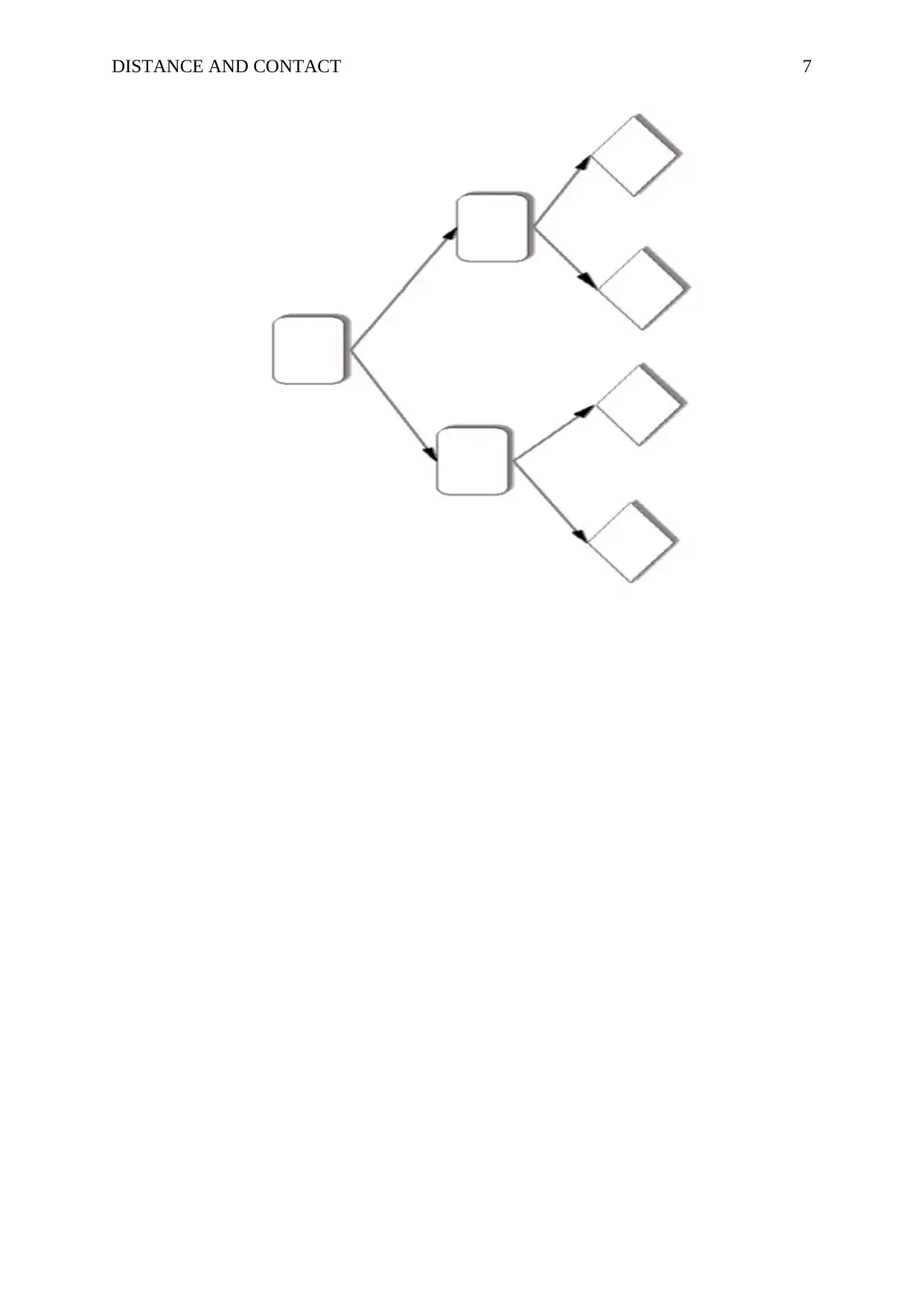
DISTANCE AND CONTACT 7
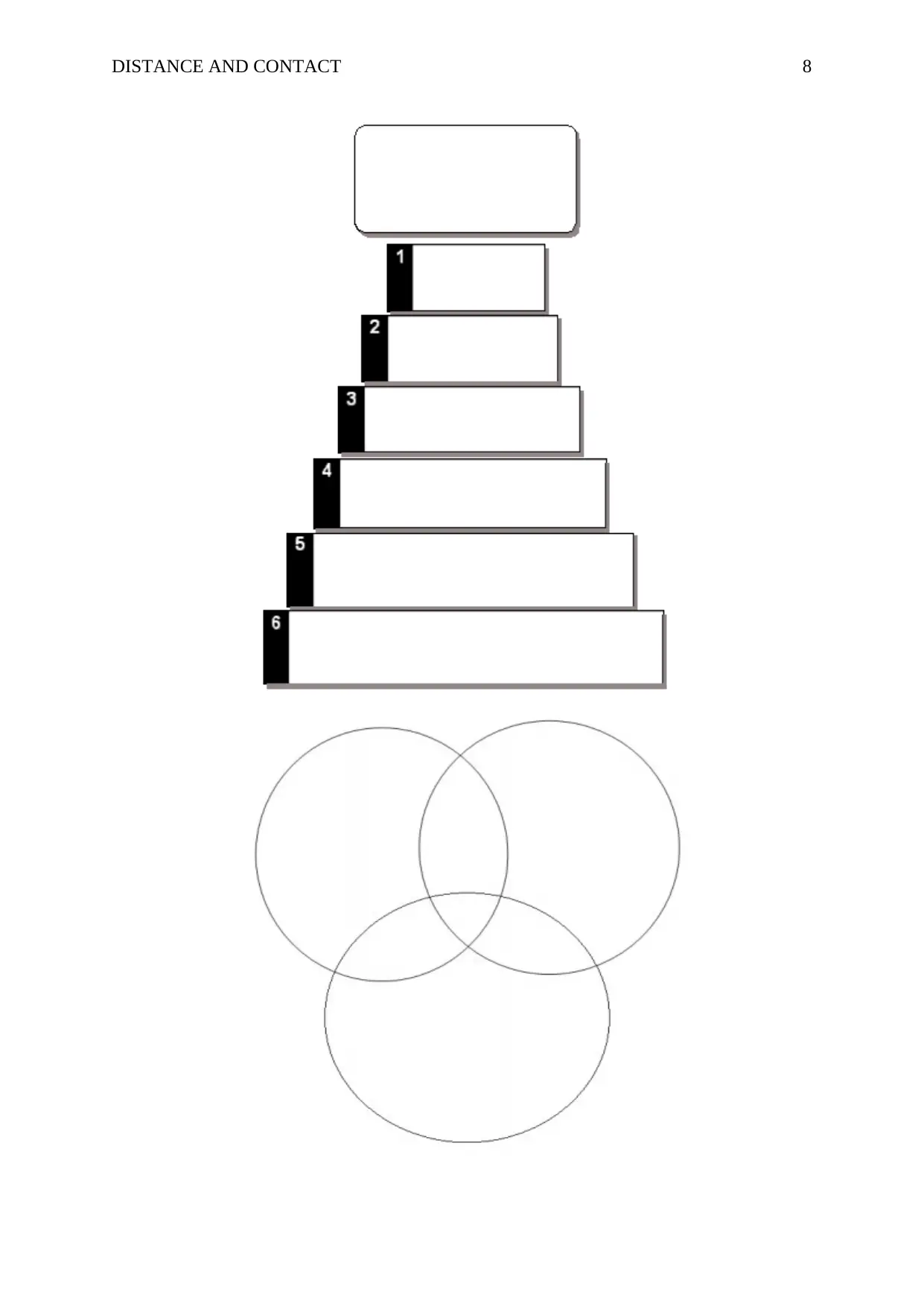
DISTANCE AND CONTACT 8
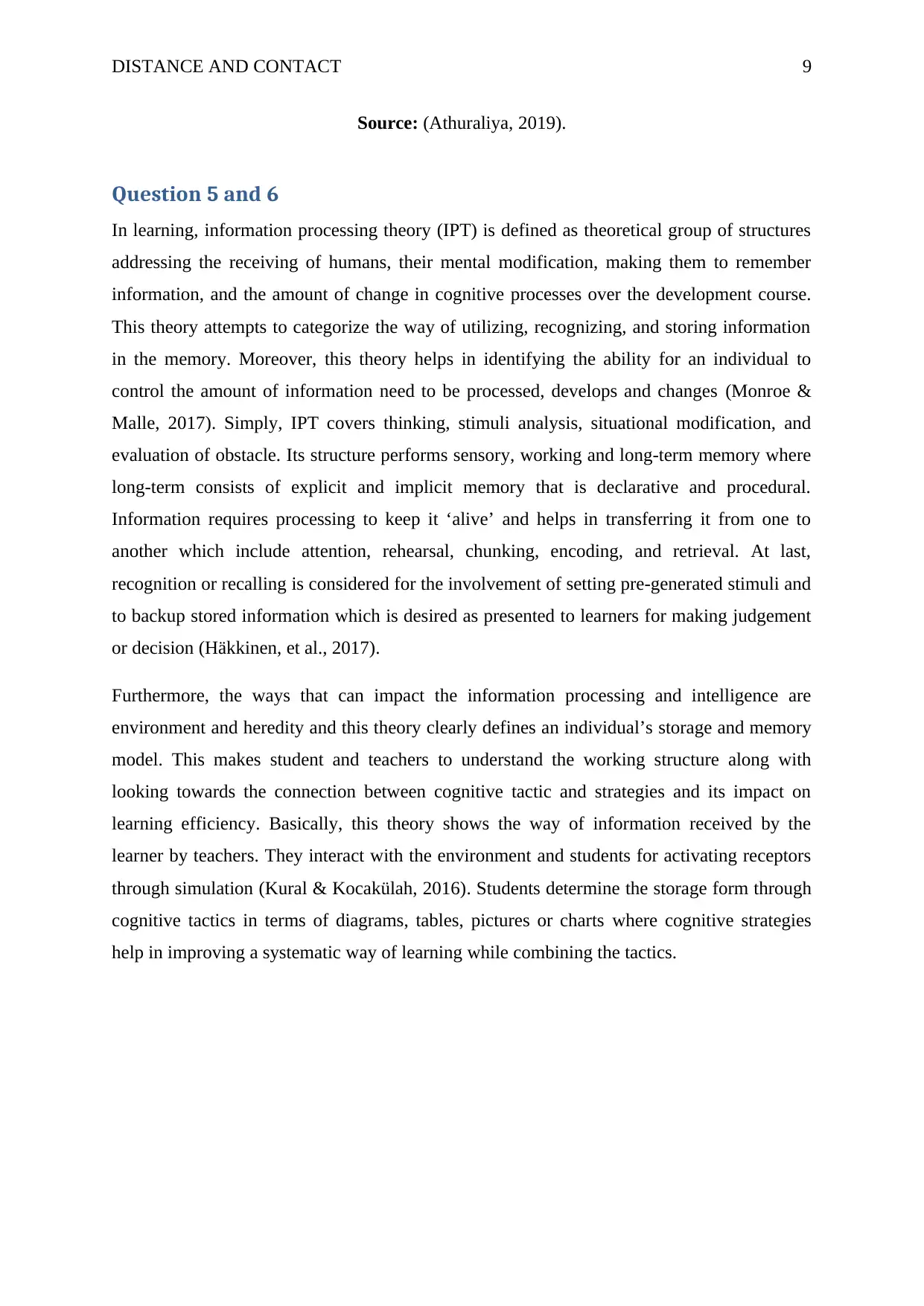
DISTANCE AND CONTACT 9
Source: (Athuraliya, 2019).
Question 5 and 6
In learning, information processing theory (IPT) is defined as theoretical group of structures
addressing the receiving of humans, their mental modification, making them to remember
information, and the amount of change in cognitive processes over the development course.
This theory attempts to categorize the way of utilizing, recognizing, and storing information
in the memory. Moreover, this theory helps in identifying the ability for an individual to
control the amount of information need to be processed, develops and changes (Monroe &
Malle, 2017). Simply, IPT covers thinking, stimuli analysis, situational modification, and
evaluation of obstacle. Its structure performs sensory, working and long-term memory where
long-term consists of explicit and implicit memory that is declarative and procedural.
Information requires processing to keep it ‘alive’ and helps in transferring it from one to
another which include attention, rehearsal, chunking, encoding, and retrieval. At last,
recognition or recalling is considered for the involvement of setting pre-generated stimuli and
to backup stored information which is desired as presented to learners for making judgement
or decision (Häkkinen, et al., 2017).
Furthermore, the ways that can impact the information processing and intelligence are
environment and heredity and this theory clearly defines an individual’s storage and memory
model. This makes student and teachers to understand the working structure along with
looking towards the connection between cognitive tactic and strategies and its impact on
learning efficiency. Basically, this theory shows the way of information received by the
learner by teachers. They interact with the environment and students for activating receptors
through simulation (Kural & Kocakülah, 2016). Students determine the storage form through
cognitive tactics in terms of diagrams, tables, pictures or charts where cognitive strategies
help in improving a systematic way of learning while combining the tactics.
Source: (Athuraliya, 2019).
Question 5 and 6
In learning, information processing theory (IPT) is defined as theoretical group of structures
addressing the receiving of humans, their mental modification, making them to remember
information, and the amount of change in cognitive processes over the development course.
This theory attempts to categorize the way of utilizing, recognizing, and storing information
in the memory. Moreover, this theory helps in identifying the ability for an individual to
control the amount of information need to be processed, develops and changes (Monroe &
Malle, 2017). Simply, IPT covers thinking, stimuli analysis, situational modification, and
evaluation of obstacle. Its structure performs sensory, working and long-term memory where
long-term consists of explicit and implicit memory that is declarative and procedural.
Information requires processing to keep it ‘alive’ and helps in transferring it from one to
another which include attention, rehearsal, chunking, encoding, and retrieval. At last,
recognition or recalling is considered for the involvement of setting pre-generated stimuli and
to backup stored information which is desired as presented to learners for making judgement
or decision (Häkkinen, et al., 2017).
Furthermore, the ways that can impact the information processing and intelligence are
environment and heredity and this theory clearly defines an individual’s storage and memory
model. This makes student and teachers to understand the working structure along with
looking towards the connection between cognitive tactic and strategies and its impact on
learning efficiency. Basically, this theory shows the way of information received by the
learner by teachers. They interact with the environment and students for activating receptors
through simulation (Kural & Kocakülah, 2016). Students determine the storage form through
cognitive tactics in terms of diagrams, tables, pictures or charts where cognitive strategies
help in improving a systematic way of learning while combining the tactics.
Secure Best Marks with AI Grader
Need help grading? Try our AI Grader for instant feedback on your assignments.
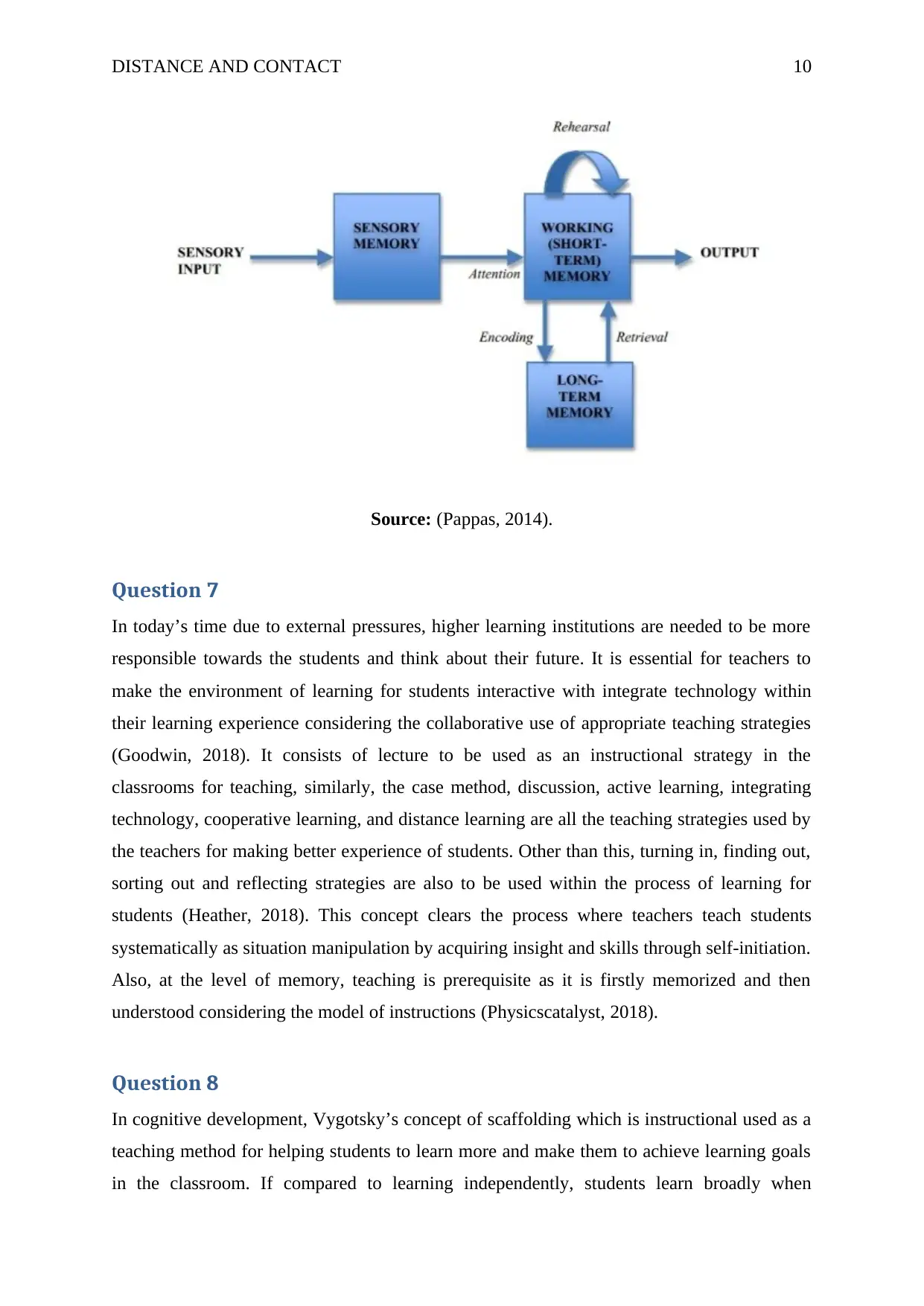
DISTANCE AND CONTACT 10
Source: (Pappas, 2014).
Question 7
In today’s time due to external pressures, higher learning institutions are needed to be more
responsible towards the students and think about their future. It is essential for teachers to
make the environment of learning for students interactive with integrate technology within
their learning experience considering the collaborative use of appropriate teaching strategies
(Goodwin, 2018). It consists of lecture to be used as an instructional strategy in the
classrooms for teaching, similarly, the case method, discussion, active learning, integrating
technology, cooperative learning, and distance learning are all the teaching strategies used by
the teachers for making better experience of students. Other than this, turning in, finding out,
sorting out and reflecting strategies are also to be used within the process of learning for
students (Heather, 2018). This concept clears the process where teachers teach students
systematically as situation manipulation by acquiring insight and skills through self-initiation.
Also, at the level of memory, teaching is prerequisite as it is firstly memorized and then
understood considering the model of instructions (Physicscatalyst, 2018).
Question 8
In cognitive development, Vygotsky’s concept of scaffolding which is instructional used as a
teaching method for helping students to learn more and make them to achieve learning goals
in the classroom. If compared to learning independently, students learn broadly when
Source: (Pappas, 2014).
Question 7
In today’s time due to external pressures, higher learning institutions are needed to be more
responsible towards the students and think about their future. It is essential for teachers to
make the environment of learning for students interactive with integrate technology within
their learning experience considering the collaborative use of appropriate teaching strategies
(Goodwin, 2018). It consists of lecture to be used as an instructional strategy in the
classrooms for teaching, similarly, the case method, discussion, active learning, integrating
technology, cooperative learning, and distance learning are all the teaching strategies used by
the teachers for making better experience of students. Other than this, turning in, finding out,
sorting out and reflecting strategies are also to be used within the process of learning for
students (Heather, 2018). This concept clears the process where teachers teach students
systematically as situation manipulation by acquiring insight and skills through self-initiation.
Also, at the level of memory, teaching is prerequisite as it is firstly memorized and then
understood considering the model of instructions (Physicscatalyst, 2018).
Question 8
In cognitive development, Vygotsky’s concept of scaffolding which is instructional used as a
teaching method for helping students to learn more and make them to achieve learning goals
in the classroom. If compared to learning independently, students learn broadly when
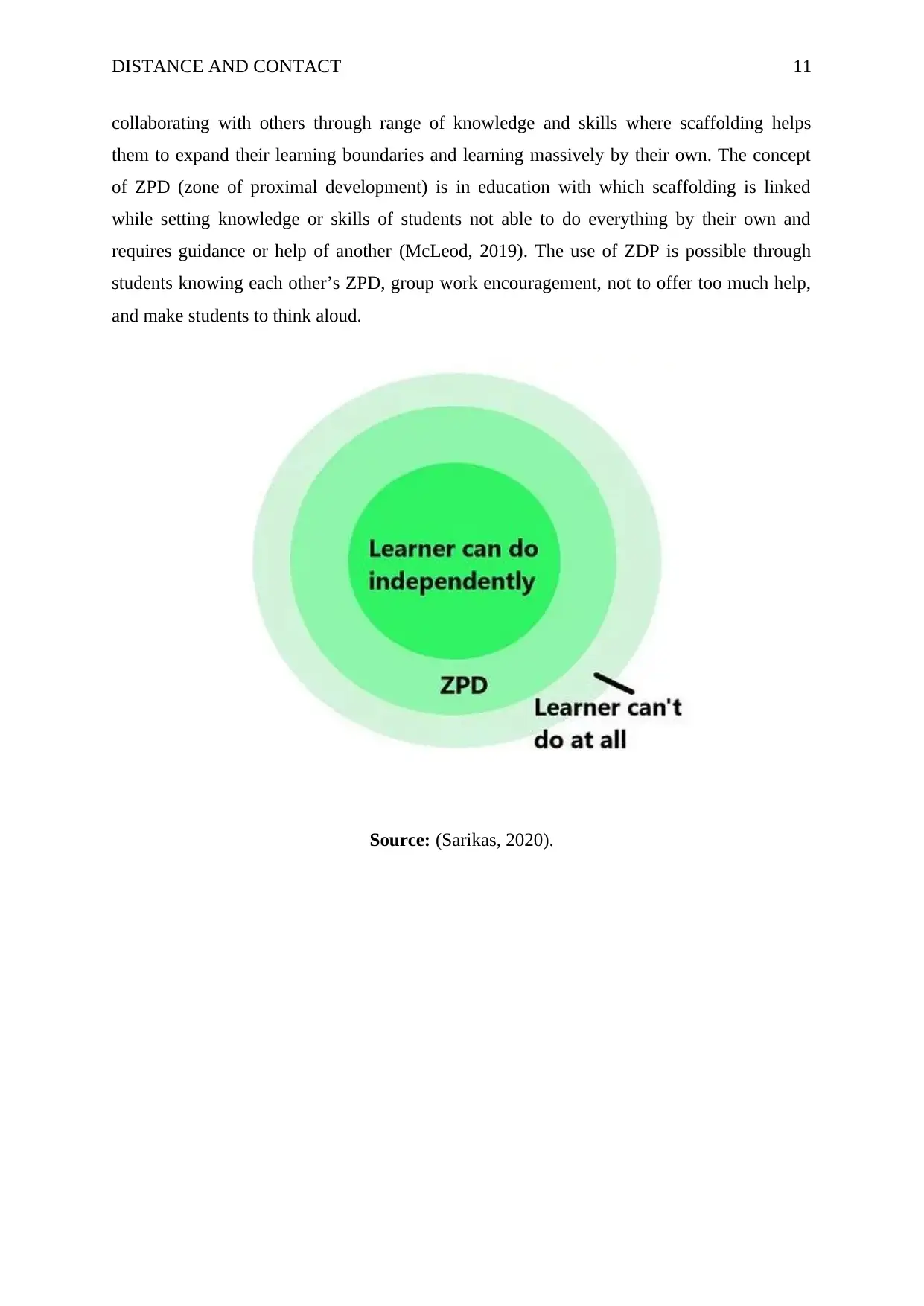
DISTANCE AND CONTACT 11
collaborating with others through range of knowledge and skills where scaffolding helps
them to expand their learning boundaries and learning massively by their own. The concept
of ZPD (zone of proximal development) is in education with which scaffolding is linked
while setting knowledge or skills of students not able to do everything by their own and
requires guidance or help of another (McLeod, 2019). The use of ZDP is possible through
students knowing each other’s ZPD, group work encouragement, not to offer too much help,
and make students to think aloud.
Source: (Sarikas, 2020).
collaborating with others through range of knowledge and skills where scaffolding helps
them to expand their learning boundaries and learning massively by their own. The concept
of ZPD (zone of proximal development) is in education with which scaffolding is linked
while setting knowledge or skills of students not able to do everything by their own and
requires guidance or help of another (McLeod, 2019). The use of ZDP is possible through
students knowing each other’s ZPD, group work encouragement, not to offer too much help,
and make students to think aloud.
Source: (Sarikas, 2020).
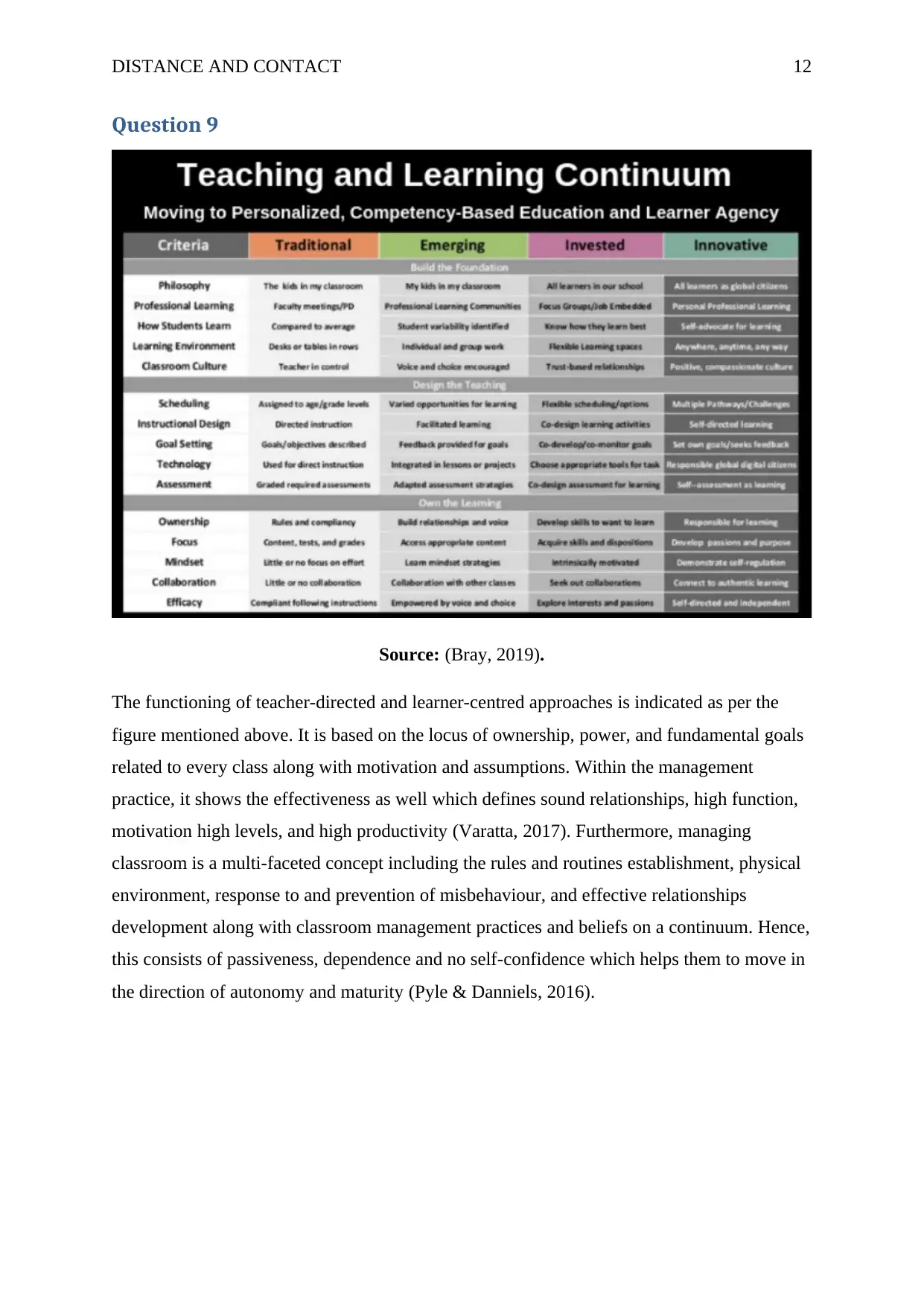
DISTANCE AND CONTACT 12
Question 9
Source: (Bray, 2019).
The functioning of teacher-directed and learner-centred approaches is indicated as per the
figure mentioned above. It is based on the locus of ownership, power, and fundamental goals
related to every class along with motivation and assumptions. Within the management
practice, it shows the effectiveness as well which defines sound relationships, high function,
motivation high levels, and high productivity (Varatta, 2017). Furthermore, managing
classroom is a multi-faceted concept including the rules and routines establishment, physical
environment, response to and prevention of misbehaviour, and effective relationships
development along with classroom management practices and beliefs on a continuum. Hence,
this consists of passiveness, dependence and no self-confidence which helps them to move in
the direction of autonomy and maturity (Pyle & Danniels, 2016).
Question 9
Source: (Bray, 2019).
The functioning of teacher-directed and learner-centred approaches is indicated as per the
figure mentioned above. It is based on the locus of ownership, power, and fundamental goals
related to every class along with motivation and assumptions. Within the management
practice, it shows the effectiveness as well which defines sound relationships, high function,
motivation high levels, and high productivity (Varatta, 2017). Furthermore, managing
classroom is a multi-faceted concept including the rules and routines establishment, physical
environment, response to and prevention of misbehaviour, and effective relationships
development along with classroom management practices and beliefs on a continuum. Hence,
this consists of passiveness, dependence and no self-confidence which helps them to move in
the direction of autonomy and maturity (Pyle & Danniels, 2016).
Paraphrase This Document
Need a fresh take? Get an instant paraphrase of this document with our AI Paraphraser
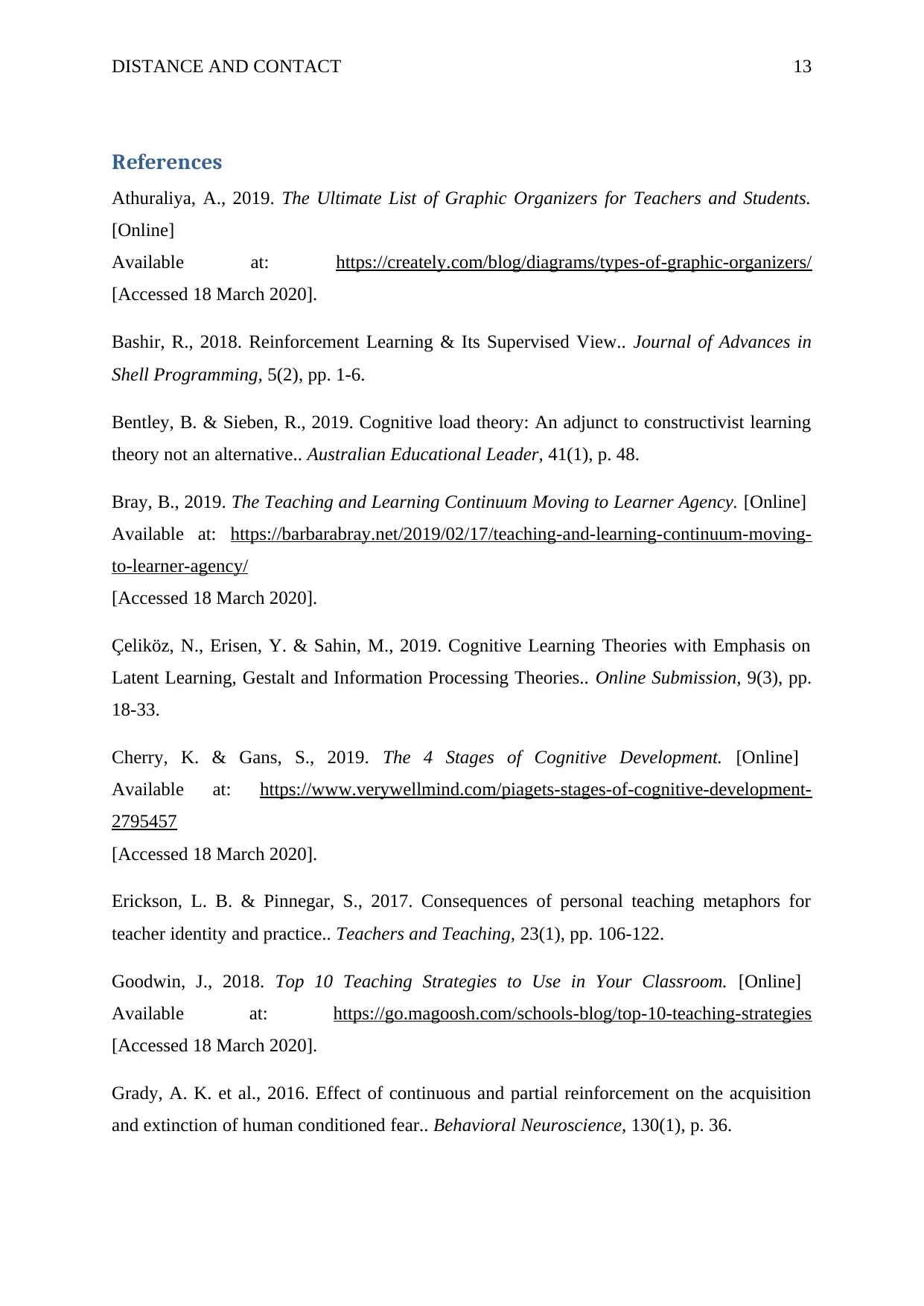
DISTANCE AND CONTACT 13
References
Athuraliya, A., 2019. The Ultimate List of Graphic Organizers for Teachers and Students.
[Online]
Available at: https://creately.com/blog/diagrams/types-of-graphic-organizers/
[Accessed 18 March 2020].
Bashir, R., 2018. Reinforcement Learning & Its Supervised View.. Journal of Advances in
Shell Programming, 5(2), pp. 1-6.
Bentley, B. & Sieben, R., 2019. Cognitive load theory: An adjunct to constructivist learning
theory not an alternative.. Australian Educational Leader, 41(1), p. 48.
Bray, B., 2019. The Teaching and Learning Continuum Moving to Learner Agency. [Online]
Available at: https://barbarabray.net/2019/02/17/teaching-and-learning-continuum-moving-
to-learner-agency/
[Accessed 18 March 2020].
Çeliköz, N., Erisen, Y. & Sahin, M., 2019. Cognitive Learning Theories with Emphasis on
Latent Learning, Gestalt and Information Processing Theories.. Online Submission, 9(3), pp.
18-33.
Cherry, K. & Gans, S., 2019. The 4 Stages of Cognitive Development. [Online]
Available at: https://www.verywellmind.com/piagets-stages-of-cognitive-development-
2795457
[Accessed 18 March 2020].
Erickson, L. B. & Pinnegar, S., 2017. Consequences of personal teaching metaphors for
teacher identity and practice.. Teachers and Teaching, 23(1), pp. 106-122.
Goodwin, J., 2018. Top 10 Teaching Strategies to Use in Your Classroom. [Online]
Available at: https://go.magoosh.com/schools-blog/top-10-teaching-strategies
[Accessed 18 March 2020].
Grady, A. K. et al., 2016. Effect of continuous and partial reinforcement on the acquisition
and extinction of human conditioned fear.. Behavioral Neuroscience, 130(1), p. 36.
References
Athuraliya, A., 2019. The Ultimate List of Graphic Organizers for Teachers and Students.
[Online]
Available at: https://creately.com/blog/diagrams/types-of-graphic-organizers/
[Accessed 18 March 2020].
Bashir, R., 2018. Reinforcement Learning & Its Supervised View.. Journal of Advances in
Shell Programming, 5(2), pp. 1-6.
Bentley, B. & Sieben, R., 2019. Cognitive load theory: An adjunct to constructivist learning
theory not an alternative.. Australian Educational Leader, 41(1), p. 48.
Bray, B., 2019. The Teaching and Learning Continuum Moving to Learner Agency. [Online]
Available at: https://barbarabray.net/2019/02/17/teaching-and-learning-continuum-moving-
to-learner-agency/
[Accessed 18 March 2020].
Çeliköz, N., Erisen, Y. & Sahin, M., 2019. Cognitive Learning Theories with Emphasis on
Latent Learning, Gestalt and Information Processing Theories.. Online Submission, 9(3), pp.
18-33.
Cherry, K. & Gans, S., 2019. The 4 Stages of Cognitive Development. [Online]
Available at: https://www.verywellmind.com/piagets-stages-of-cognitive-development-
2795457
[Accessed 18 March 2020].
Erickson, L. B. & Pinnegar, S., 2017. Consequences of personal teaching metaphors for
teacher identity and practice.. Teachers and Teaching, 23(1), pp. 106-122.
Goodwin, J., 2018. Top 10 Teaching Strategies to Use in Your Classroom. [Online]
Available at: https://go.magoosh.com/schools-blog/top-10-teaching-strategies
[Accessed 18 March 2020].
Grady, A. K. et al., 2016. Effect of continuous and partial reinforcement on the acquisition
and extinction of human conditioned fear.. Behavioral Neuroscience, 130(1), p. 36.
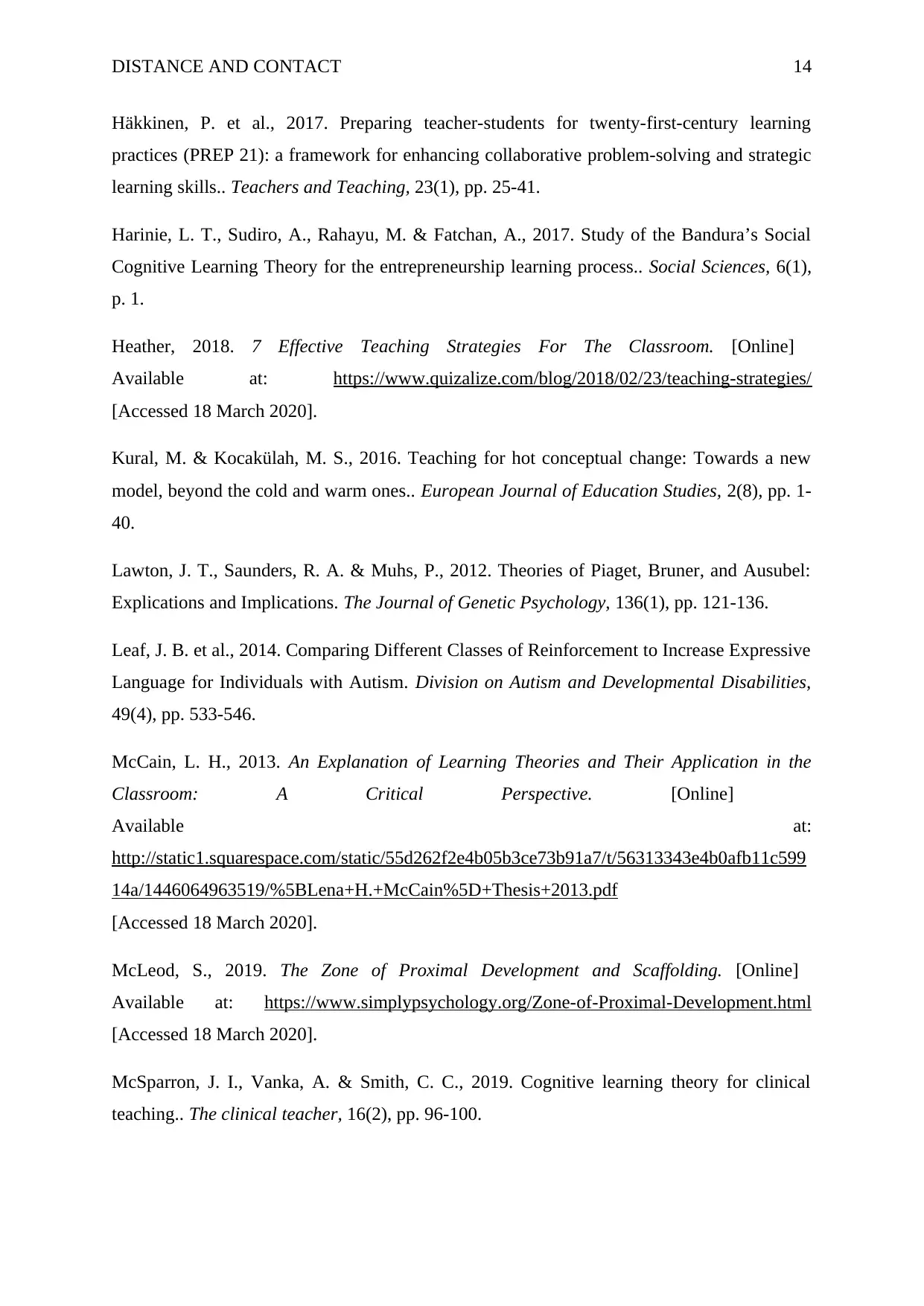
DISTANCE AND CONTACT 14
Häkkinen, P. et al., 2017. Preparing teacher-students for twenty-first-century learning
practices (PREP 21): a framework for enhancing collaborative problem-solving and strategic
learning skills.. Teachers and Teaching, 23(1), pp. 25-41.
Harinie, L. T., Sudiro, A., Rahayu, M. & Fatchan, A., 2017. Study of the Bandura’s Social
Cognitive Learning Theory for the entrepreneurship learning process.. Social Sciences, 6(1),
p. 1.
Heather, 2018. 7 Effective Teaching Strategies For The Classroom. [Online]
Available at: https://www.quizalize.com/blog/2018/02/23/teaching-strategies/
[Accessed 18 March 2020].
Kural, M. & Kocakülah, M. S., 2016. Teaching for hot conceptual change: Towards a new
model, beyond the cold and warm ones.. European Journal of Education Studies, 2(8), pp. 1-
40.
Lawton, J. T., Saunders, R. A. & Muhs, P., 2012. Theories of Piaget, Bruner, and Ausubel:
Explications and Implications. The Journal of Genetic Psychology, 136(1), pp. 121-136.
Leaf, J. B. et al., 2014. Comparing Different Classes of Reinforcement to Increase Expressive
Language for Individuals with Autism. Division on Autism and Developmental Disabilities,
49(4), pp. 533-546.
McCain, L. H., 2013. An Explanation of Learning Theories and Their Application in the
Classroom: A Critical Perspective. [Online]
Available at:
http://static1.squarespace.com/static/55d262f2e4b05b3ce73b91a7/t/56313343e4b0afb11c599
14a/1446064963519/%5BLena+H.+McCain%5D+Thesis+2013.pdf
[Accessed 18 March 2020].
McLeod, S., 2019. The Zone of Proximal Development and Scaffolding. [Online]
Available at: https://www.simplypsychology.org/Zone-of-Proximal-Development.html
[Accessed 18 March 2020].
McSparron, J. I., Vanka, A. & Smith, C. C., 2019. Cognitive learning theory for clinical
teaching.. The clinical teacher, 16(2), pp. 96-100.
Häkkinen, P. et al., 2017. Preparing teacher-students for twenty-first-century learning
practices (PREP 21): a framework for enhancing collaborative problem-solving and strategic
learning skills.. Teachers and Teaching, 23(1), pp. 25-41.
Harinie, L. T., Sudiro, A., Rahayu, M. & Fatchan, A., 2017. Study of the Bandura’s Social
Cognitive Learning Theory for the entrepreneurship learning process.. Social Sciences, 6(1),
p. 1.
Heather, 2018. 7 Effective Teaching Strategies For The Classroom. [Online]
Available at: https://www.quizalize.com/blog/2018/02/23/teaching-strategies/
[Accessed 18 March 2020].
Kural, M. & Kocakülah, M. S., 2016. Teaching for hot conceptual change: Towards a new
model, beyond the cold and warm ones.. European Journal of Education Studies, 2(8), pp. 1-
40.
Lawton, J. T., Saunders, R. A. & Muhs, P., 2012. Theories of Piaget, Bruner, and Ausubel:
Explications and Implications. The Journal of Genetic Psychology, 136(1), pp. 121-136.
Leaf, J. B. et al., 2014. Comparing Different Classes of Reinforcement to Increase Expressive
Language for Individuals with Autism. Division on Autism and Developmental Disabilities,
49(4), pp. 533-546.
McCain, L. H., 2013. An Explanation of Learning Theories and Their Application in the
Classroom: A Critical Perspective. [Online]
Available at:
http://static1.squarespace.com/static/55d262f2e4b05b3ce73b91a7/t/56313343e4b0afb11c599
14a/1446064963519/%5BLena+H.+McCain%5D+Thesis+2013.pdf
[Accessed 18 March 2020].
McLeod, S., 2019. The Zone of Proximal Development and Scaffolding. [Online]
Available at: https://www.simplypsychology.org/Zone-of-Proximal-Development.html
[Accessed 18 March 2020].
McSparron, J. I., Vanka, A. & Smith, C. C., 2019. Cognitive learning theory for clinical
teaching.. The clinical teacher, 16(2), pp. 96-100.
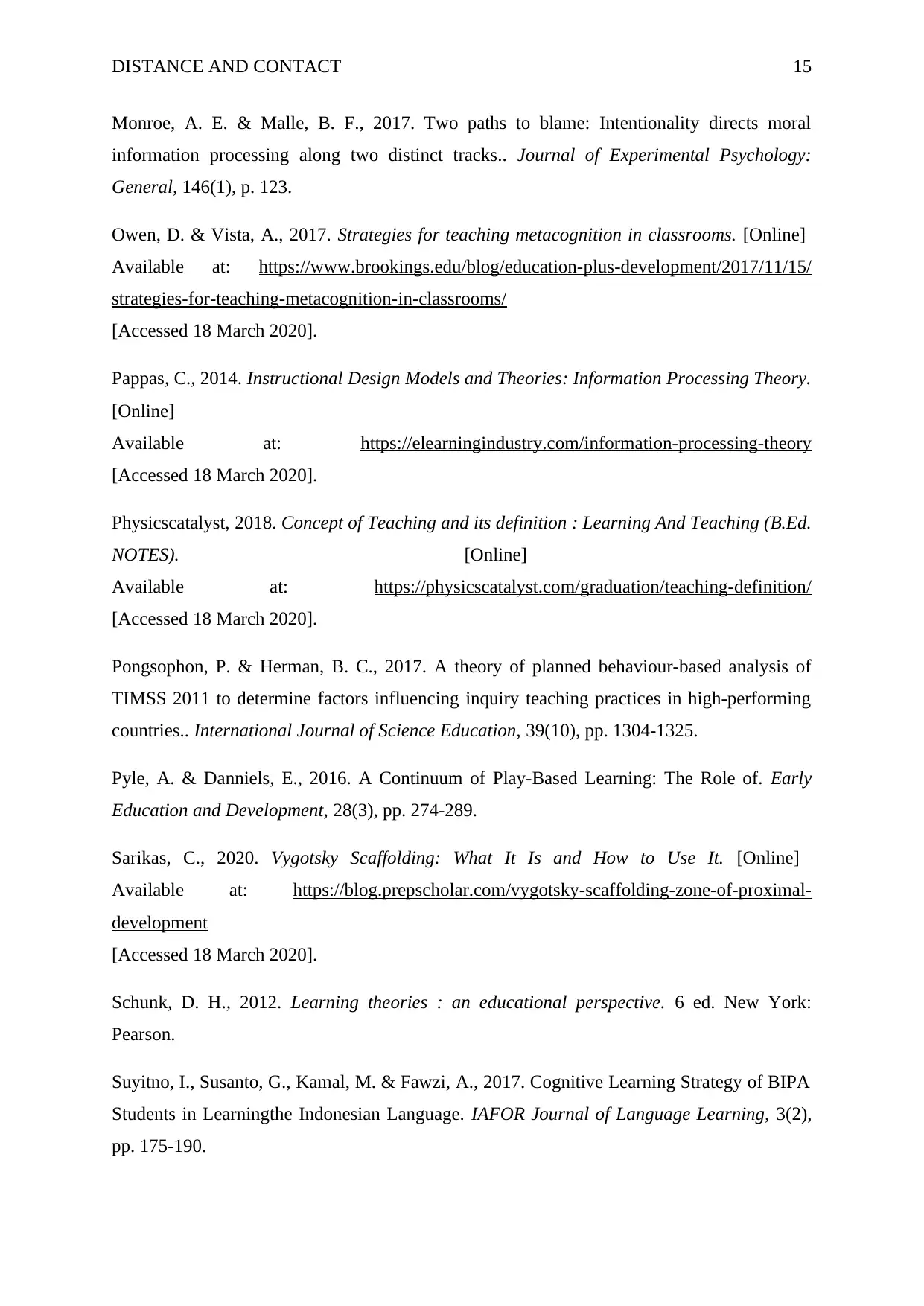
DISTANCE AND CONTACT 15
Monroe, A. E. & Malle, B. F., 2017. Two paths to blame: Intentionality directs moral
information processing along two distinct tracks.. Journal of Experimental Psychology:
General, 146(1), p. 123.
Owen, D. & Vista, A., 2017. Strategies for teaching metacognition in classrooms. [Online]
Available at: https://www.brookings.edu/blog/education-plus-development/2017/11/15/
strategies-for-teaching-metacognition-in-classrooms/
[Accessed 18 March 2020].
Pappas, C., 2014. Instructional Design Models and Theories: Information Processing Theory.
[Online]
Available at: https://elearningindustry.com/information-processing-theory
[Accessed 18 March 2020].
Physicscatalyst, 2018. Concept of Teaching and its definition : Learning And Teaching (B.Ed.
NOTES). [Online]
Available at: https://physicscatalyst.com/graduation/teaching-definition/
[Accessed 18 March 2020].
Pongsophon, P. & Herman, B. C., 2017. A theory of planned behaviour-based analysis of
TIMSS 2011 to determine factors influencing inquiry teaching practices in high-performing
countries.. International Journal of Science Education, 39(10), pp. 1304-1325.
Pyle, A. & Danniels, E., 2016. A Continuum of Play-Based Learning: The Role of. Early
Education and Development, 28(3), pp. 274-289.
Sarikas, C., 2020. Vygotsky Scaffolding: What It Is and How to Use It. [Online]
Available at: https://blog.prepscholar.com/vygotsky-scaffolding-zone-of-proximal-
development
[Accessed 18 March 2020].
Schunk, D. H., 2012. Learning theories : an educational perspective. 6 ed. New York:
Pearson.
Suyitno, I., Susanto, G., Kamal, M. & Fawzi, A., 2017. Cognitive Learning Strategy of BIPA
Students in Learningthe Indonesian Language. IAFOR Journal of Language Learning, 3(2),
pp. 175-190.
Monroe, A. E. & Malle, B. F., 2017. Two paths to blame: Intentionality directs moral
information processing along two distinct tracks.. Journal of Experimental Psychology:
General, 146(1), p. 123.
Owen, D. & Vista, A., 2017. Strategies for teaching metacognition in classrooms. [Online]
Available at: https://www.brookings.edu/blog/education-plus-development/2017/11/15/
strategies-for-teaching-metacognition-in-classrooms/
[Accessed 18 March 2020].
Pappas, C., 2014. Instructional Design Models and Theories: Information Processing Theory.
[Online]
Available at: https://elearningindustry.com/information-processing-theory
[Accessed 18 March 2020].
Physicscatalyst, 2018. Concept of Teaching and its definition : Learning And Teaching (B.Ed.
NOTES). [Online]
Available at: https://physicscatalyst.com/graduation/teaching-definition/
[Accessed 18 March 2020].
Pongsophon, P. & Herman, B. C., 2017. A theory of planned behaviour-based analysis of
TIMSS 2011 to determine factors influencing inquiry teaching practices in high-performing
countries.. International Journal of Science Education, 39(10), pp. 1304-1325.
Pyle, A. & Danniels, E., 2016. A Continuum of Play-Based Learning: The Role of. Early
Education and Development, 28(3), pp. 274-289.
Sarikas, C., 2020. Vygotsky Scaffolding: What It Is and How to Use It. [Online]
Available at: https://blog.prepscholar.com/vygotsky-scaffolding-zone-of-proximal-
development
[Accessed 18 March 2020].
Schunk, D. H., 2012. Learning theories : an educational perspective. 6 ed. New York:
Pearson.
Suyitno, I., Susanto, G., Kamal, M. & Fawzi, A., 2017. Cognitive Learning Strategy of BIPA
Students in Learningthe Indonesian Language. IAFOR Journal of Language Learning, 3(2),
pp. 175-190.
Secure Best Marks with AI Grader
Need help grading? Try our AI Grader for instant feedback on your assignments.
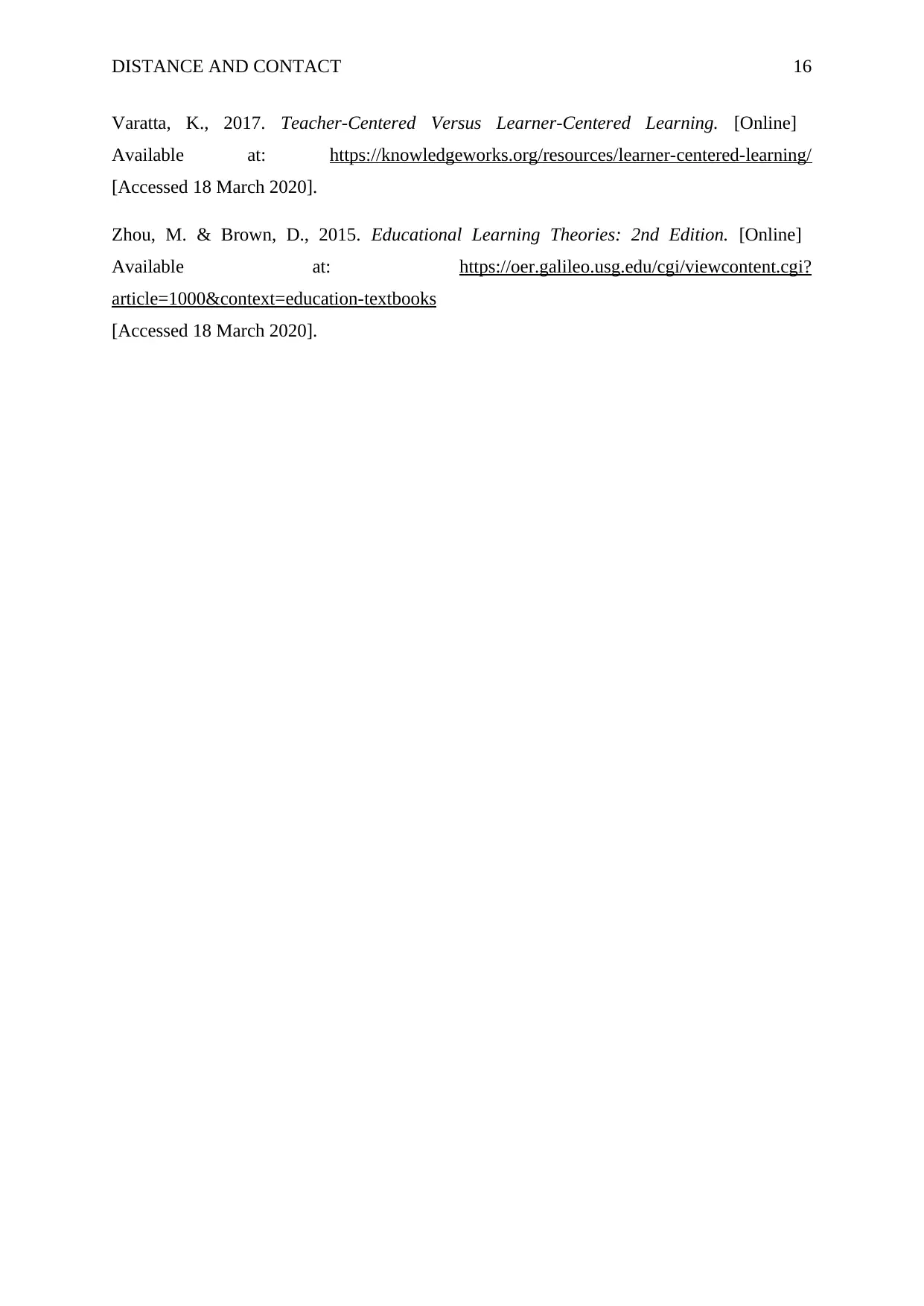
DISTANCE AND CONTACT 16
Varatta, K., 2017. Teacher-Centered Versus Learner-Centered Learning. [Online]
Available at: https://knowledgeworks.org/resources/learner-centered-learning/
[Accessed 18 March 2020].
Zhou, M. & Brown, D., 2015. Educational Learning Theories: 2nd Edition. [Online]
Available at: https://oer.galileo.usg.edu/cgi/viewcontent.cgi?
article=1000&context=education-textbooks
[Accessed 18 March 2020].
Varatta, K., 2017. Teacher-Centered Versus Learner-Centered Learning. [Online]
Available at: https://knowledgeworks.org/resources/learner-centered-learning/
[Accessed 18 March 2020].
Zhou, M. & Brown, D., 2015. Educational Learning Theories: 2nd Edition. [Online]
Available at: https://oer.galileo.usg.edu/cgi/viewcontent.cgi?
article=1000&context=education-textbooks
[Accessed 18 March 2020].
1 out of 17
Your All-in-One AI-Powered Toolkit for Academic Success.
+13062052269
info@desklib.com
Available 24*7 on WhatsApp / Email
![[object Object]](/_next/static/media/star-bottom.7253800d.svg)
Unlock your academic potential
© 2024 | Zucol Services PVT LTD | All rights reserved.